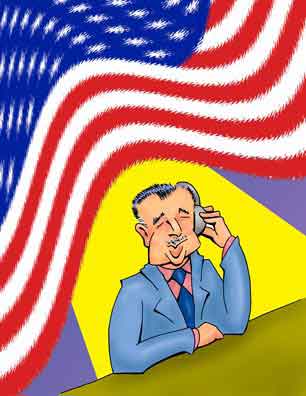Walter Cronkite
The Most Trusted Man in America

Walter Cronkite
The Most Trusted Man in America
When he began broadcasting the news in 1962, Walter Cronkite decided he'd end his show saying, "For more details, see your local newspaper." That was because he realized that television was long on action - it was quite dramatic showing policeman attacking people with tear gas, billy clubs, and attack dogs simply because they wanted to register to vote - but it was short on detail. For impact, television was great. But for getting the nitty-gritty, you had to turn to print.
Alas, Walter's thinking did not set well with the CBS bosses. They didn't want him to get the viewers thinking they might get more information from those archaic low-tech (ptui) newspapers. So Walter had to come up with a new sign-off. Ultimately he decided on "And that's the way it is ..." and then gave the day, date, and year.
Walter lived well into the Internet Age and perhaps his concerns were ameliorated by the rise of the Web as the primary text based news source. Today a lot of print stories - by print we mean news websites - also have a video about the story. You can watch the video for a quick summary and then read the details. On the other hand some readers don't think a summary read from a teleprompter by overly-coiffured anchors is much of a help and so they just stop the video and jump to the text.
Of course, you can argue it no longer matters. With the cheap availability of cyberspace, the news stories are more and more buried by the plethora of opinion pieces ("thought pieces" is too generous a term) splattered about the net. Certainly Walter lamented the sensationalizing and trivialization of news.
Walter began working for CBS in 1950 and his reassuring on-camera persona was such that he was assigned to anchor the election coverage in 1952 between Dwight Eisenhower and Adlai Stevenson. The traditional polls had shown that Ike would win by a comfortable margin. Only in the last few weeks did the gap (apparently) close, and it looked like Adlai might actually win,
This was also the early days of computers although there wasn't much interest in these huge vacuum tube packed monstrosities among the general public. But the heads at CBS called up the Remington Rand Corporation and made arrangements where their fancypants electronic brain (as they called it) would be used to forecast the election results.
The computer used was the Universal Automatic Computer (UNIVAC). Arthur Draper, who was the research director for advanced research at Remington Rand, was managing the operation, and reporter Charles Collingwood was in touch with Arthur and reported the findings to the television audience.
After 3 million votes were in, the network gave UNIVAC a try. It predicted Adlai Stevenson would win only 93 electoral votes and 5 states. Ike, the prediction said, would garner 43 states and 438 electoral votes. Shoot, the programmers said, that can't be right. The polls show Ike and Adlai are almost neck and neck. So obviously the previous trends must be biasing the predictions too much. So the programmers removed some of the earlier data and gave the calculations another whack.
The results were much better. After a bit more tweaking, UNIVAC finally predicted Stephenson would win 20 states and Ike 28. And Stephenson would end up with 217 electoral votes to Ike's 314. Ike would still win according to UNIVAC but not by such a ridiculous margin as the earlier prediction.
Well, the humans should have left the computer alone. The original prediction was almost right on. Ike ended up winning with 39 states and 442 electoral votes while Adlai only cleaned up 9 states and 89 electoral votes. And Charles told us the computer was much faster than people.
How fast was the computer? Well, when Charles was explaining the computer to the viewers, he pointed out that UNIVAC could actually perform 2000 additions a second! Not only that, he added, it could handle 500 subtractions and even a whopping 250 divisions per second!
Impressive.
At first, Walter's show had #2 ranking behind the Huntley-Brinkley Report. But that changed after the mid-1960's and Walter took the #1 slot. David, though, later spoke of his respect and friendship for Walter. You can, of course, be competitors and still be friends.

Chet and David
Competitors
Even in his most active years Walter was concerned with the education of America's kids. He hosted a number of educational shows - now scandalously being replaced by - quote - "documentaries" - unquote - about non-existent prehistoric beasts or strange visitors from another planet who created ancient monuments because obviously the people in the time and place were too stupid to figure out how to build ramps and pile rocks on top of each other. After all, one television show assured us, the ancients must needs have anti-gravity devices since the primitive cultures didn't have the wheel. That's a strange culture, all right. So advanced they had anti-gravity devices. But they didn't have the wheel.
The most famous of Water's educational programs was You Are There which began in 1953. The format varied a bit but usually Walter would appear on screen in his usual role as the anchor man but reporting on "breaking" news from years ago - such as the death of Socrates, the assassination of Julius Caesar, the travels of Marco Polo, the signing of the Declaration of Independence, the treason of Benedict Arnold, the surrender of Cornwallis at Yorktown, the mutiny on the Bounty, the battle of the Alamo, Henry Morton Stanley finding Dr. Livingstone, the Chicago Fire, the capture of Jesse James, the shootout at Coffeyville with the Dalton Gang, and the attack on Pearl Harbor.
The show was actually intended for kids and to be frank today the scenes comes off a bit hokey. Actors would play the parts of historical figures being interviewed on camera by "on-the-spot" reporters. For recent events (like Pearl Harbor), Walter would show archive footage, but otherwise would have to use clips from old movies or reenactments.
The show lasted from 1953 to 1957 and enjoyed a brief return in 1971. In the new show Walter again played himself as a news anchor and as before, he was aided by his correspondents. Once a camera crew happened to be in the forest when Harriet Tubman came by leading some runaway slaves to freedom. Roger Mudd stepped out with a microphone for a quick comment from Harriet.
Some of the stories about Walter are very interesting, and one of the most famous was that Walter gave an editorial about how the Vietnam War was in a stalemate and that probably the only way out was a negotiated settlement. Walter said he learned that President Lyndon Johnson was watching the news - LBJ sometimes had three televisions going at once - and turned to an aide.
"Well," he said, "if I've lost Cronkite, I've lost middle America."
Five months later Lyndon announced he would not run for a second term.
Alas, the story isn't true and to keep up the trust we have to point out that Walter did not claim he had first hand knowledge of the story. He simply said that he heard that's what Lyndon said. But a professor at American University checked on the date and on what Lyndon was doing that day.
Yes, Walter gave the editorial the night of February 27, 1968. But we know Lyndon wasn't watching. At that time, he was attending a dinner for the then-Governor of Texas John Connolly. Also such a comment was uncharacteristic of Lyndon who Walter said if he didn't like what a reporter said would literally lift the man up by the collar (we don't have any suggestion LBJ treated the ladies this way) and push his face nose-to-nose before stating in no uncertain tones that he didn't like the story. Walter pointed out that when he and LBJ met nose to nose there wasn't much room to spare.
Not that we can say the story is entirely untrue. It's very likely Lyndon was told of the editorial and then made the comment. We will, of course, never know.
On television Walter came off as staid, serious, and even a bit of a stuffed-shirt. In his private life, though, Walter was much more relaxed. He was a dedicated sailor and spent his time off on Martha's Vineyard with his 48 foot sailing yacht. Local residents remembered him as friendly and always involved in the local issues of the day and ready to give his time to the community. Once he thought his wife might like a couple of kittens. Rather than go to a high end pedigree cat factory, he went to the local animal shelter. So how can anyone doubt Walter's well-merited reputation as the most trusted man in America?
Of course, there is always a difference of opinion and there was at least one person in the United States who disagreed. That was John W. Dean, III. John, as the decreasing number of people who remember the Watergate Scandal know, was White House Counsel to President Richard Nixon from 1970 to 1973. He later pled guilty to obstruction of justice for his involvement in the Watergate cover-up. John got whacked with 1 to 4 years but Judge "Mamximum John" Sirica, belying his monicker, later reduced the sentence to time served which was four months.
But John, who actually did seem to feel bad about helping one of the most dangerous and nutty men ever to hold the office of President subvert the electoral process, was once to be interviewed by Walter about the political conventions in 1976 and which John was covering for Rolling Stone Magazine - a role that many of the regular correspondents resented. John said he and Walter - or at least Walter's helpers - made an agreement not to discuss his upcoming book about the Watergate scandal.
As John told it when he got on camera the first thing Walter did was ask if there were new revelations about Watergate in his upcoming book. John said he gave an evasive answer to the effect of, well, we'll have to wait and see. Walter kept trying to broach the subject, and John kept giving non-answers and eventually the interview fell apart. John was miffed (as was Walter) and in his book John described Walter using a rather discourteous term. Of course we don't have Walter's side of the story.
But we have to admit it. Anyone can have lapses of judgement. Even Walter.
What? Walter?
Yes, even Walter.
And the proof?
Well, there was one time Walter really messed up. It's hard to believe, but there is irrefutable evidence.
Yes, Walter Cronkite, the most trusted man in America, once appeared on ....
Pardon me, but it has to be said.
... appeared on ... and as himself on ...
... (gasp, sob) ...yes ... on ...
The Mary Tyler Moore Show!
And that's the way it is,
References
A Reporter's Life, Walter Cronkite, Knopf, 1996
"And That's the Way It Is", Dan Rottenberg, American Journalism Review, May, 1994.
"The Secret World of Walter Cronkite: A day in the life of the most trusted man in America", Al Reinert, Texas Monthly, January 1976.
Archie Bunker's America: TV in an Era of Change 1968-1978, Josh Ozersky, Southern Illinois University Press, 2003
Getting It Wrong: Ten of the Greatest Misreported Stories in American Journalism, W. Joseph Campbell, University of California Press, 2010
Lost Honor, John Dean, Stratford Press (1982)
"Interview with Walter Cronkite", Lyndon Baines Johnson Library, November 27, 2002.
CBS News Special Election Coverage, Novebmer 4, 1952.
Breakthrough to the Computer Age, Harry Wulforst, Scribner, 1982